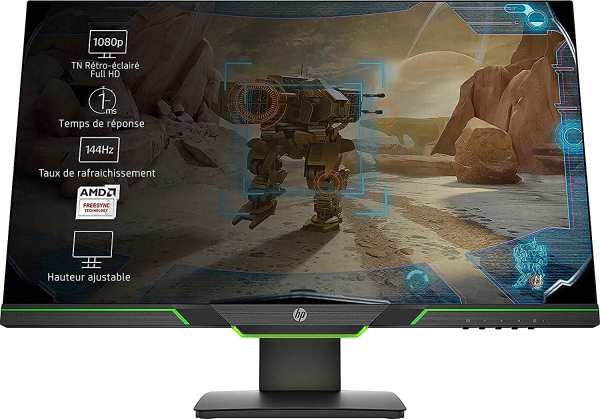HP
HP 27xq: AOC Agon AG271QX concurrent monitor
Aprox. 199€
See specificationsWith its 27-inch TN Quad HD 144 Hz TN panel, the HP 27xq monitor targets gamers at a tight price. Is it really worth the 400 € requested?
Positive points
Definition Quad HD.
144 Hz panel.
FreeSync compatibility.
Good ergonomics.
Bad points
Limited contrast.
Perfectible calibration.
Anemic connectivity.
No cable routing system.
Closed viewing angles.
Our review
Presentation
The HP 27xq has a 27 inch TN panel with a Quad HD definition of 2,560 x 1,440 px. This model supports a refresh rate of 144 Hz and it is also compatible with FreeSync technology between 48 and 144 Hz. The manufacturer announces a response time of 1 ms and reduced viewing angles (170/160 °, classic values for a TN model).
This monitor is the competitor of the AOC AG271QX equipped with the same panel, sold a little more expensive, but with more supplied connectors and above all - as we will see - better calibrated and more contrasted.
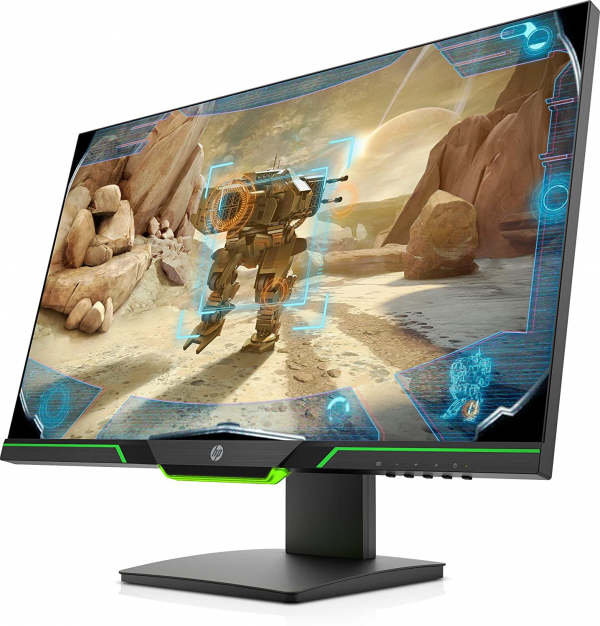
Ergonomics
The HP 27xq is a fairly discreet player monitor. Black is essential on the majority of plastics and only a few touches of green give a gaming aspect. The 27-inch slab benefits from a matt coating which limits annoying reflections.
The screen edges are fine and the finishes are quite good. Nothing to say about that side and HP has a pretty good reputation thanks to its experience in the professional field.
At the rear, the monitor does not show its player side and there is simply no difference with an office monitor. Note that HP has skipped a cable routing system; a simple opening in the foot would have done the trick. It will be for next time ...
It is possible to adjust the height to 10 cm and the tilt between -4 ° and + 20 °. The monitor also incorporates a pivot for switching to portrait mode, which is of little interest with a TN panel whose very limited angles make this mode unusable. The various adjustments are made smoothly, without any extraneous noise.
A rubber pad located under the foot allows complete rotation through 360 °. This system turns the foot as a whole and is quite sensitive. Pressing the OSD buttons, for example, turns the monitor.
If we are used to this type of light connection on G-Sync monitors, it is quite rare on the more generous FreeSYnc models. The HP 27xq monitor thus only has a DisplayPort 1.2 input, an HDMI 2.0 input and a headphone output. HP ignores a second HDMI port, built-in speakers and a USB hub that would have allowed devices to be connected directly to the screen - something that the AOC Agon AG271QX offers, its main competitor.
Gaming monitor requires, HP has all the same integrated a led at the base of the panel ... Several lighting modes are available, but only one color: green.
Four buttons located at the base of the panel allow you to access the various settings and change the source. If the menus are clear, the navigation is laborious. Above all, the OSD does not allow access to all settings. If we find the brightness, contrast, overdrive and color temperature setting, it is for example impossible to adjust the gamma.
On our 140 x 60 cm desk, the HP 27xq is discreet. The 21.6 cm deep base leaves plenty of room for the keyboard and mouse. The definition Quad HD on this diagonal of 27 inches allows to benefit from an increased workspace in office use, but ultimately has little interest in games. We find the Quad HD definition more suitable for a 32-inch model like the Samsung C32HG70. It may be suitable for those who are close to their monitor and who do not have sufficient distance for a 32-inch model. A last generation mid / high end graphics card is necessary to run the latest games at 144 Hz with the details pushed to the maximum (or almost).
This monitor consumes about 25 W with a white set at 150 cd / m². Relative consumption thus reaches 124 W / m², a value much higher than the average of the screens tested (100 W / m²) and much higher than that of the AOC AG271QX which is limited to 21 W (80 W / m²). At the minimum of the brightness (37 cd / m²), the monitor consumes 16 W and goes up to 44 W at the maximum (355 cd / m²).
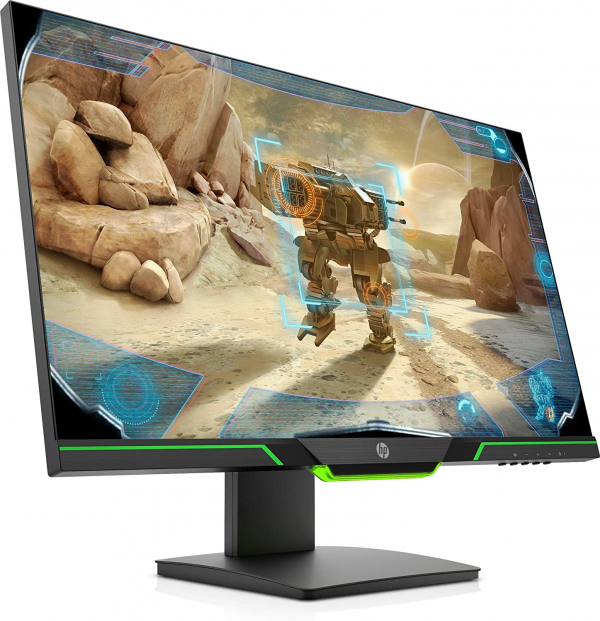
Colors and contrast
Leaving the factory, the monitor displays an image that is far from perfect. The temperature settles on an average of 7,100 K, not very far from the 6,500 K reference, but with a curve that lacks stability over the entire spectrum. The average gamma measured at 1.8 is very far from the reference value (2.2) and above all the curve is not stable. Finally, the colors are not calibrated at all. We measured an average Delta E at 6.3. Remember that beyond a Delta E of 3, the human eye can perceive the difference between the colors requested and the colors displayed. The drifts are therefore clearly visible to the naked eye.
To calibrate the screen, we chose Film mode and then lowered the brightness to 37 to try to display a better image and obtain a white at 150 cd / m² on our test pattern. There are no other manual settings that can improve things. The average temperature drops to 7,060 K, slightly closer to the 6,500 K reference, but retains the same unstable profile. The average gamma goes back to 1.9, but the curve remains the same. Finally, the colors are slightly less bad (delta E measured at 5.3), but still not faithful enough. HP does offer a temperature setting on "hot", but the average then drops too low (5,200 K), while maintaining the same slope curve. Finally, there is no adjustment to bring up the gamma.
Quite rare on a monitor, calibration with the probe does not correct all display faults. If the temperature curve is finally stable with a value very close to that of reference, it is not the case of the gamma, which preserves the same curve and still does not reach the target value. The colors are a little better, but still cannot be considered faithful. We still offer you the color profile via this link, but this screen is far from perfect, even once calibrated.
Even for a TN panel - whose contrast is therefore naturally limited - the one used by HP seems of poor quality. We measured a contrast of only 620: 1, a very low value even for a TN model. In comparison, the AOC AG271QX - also equipped with a TN panel - displays a contrast greater than 900: 1. The HP monitor, already far from the best TN models, is therefore far from the most contrasting monitors in our comparison, such as the AOC Q3279VWF, the Textorm TX32 or the Philips BDM4037UW which exceed a contrast ratio of 4,000: 1.
The average difference in brightness uniformity is measured at only 5% over the entire 27-inch panel; a benchmark that few monitors achieve. The model we tested was not affected by any clouding phenomenon. It is not the same sound on the side of the viewing angles which are poor, as on all TN monitors. From the front, a background of uniform color will be displayed with a gradient.
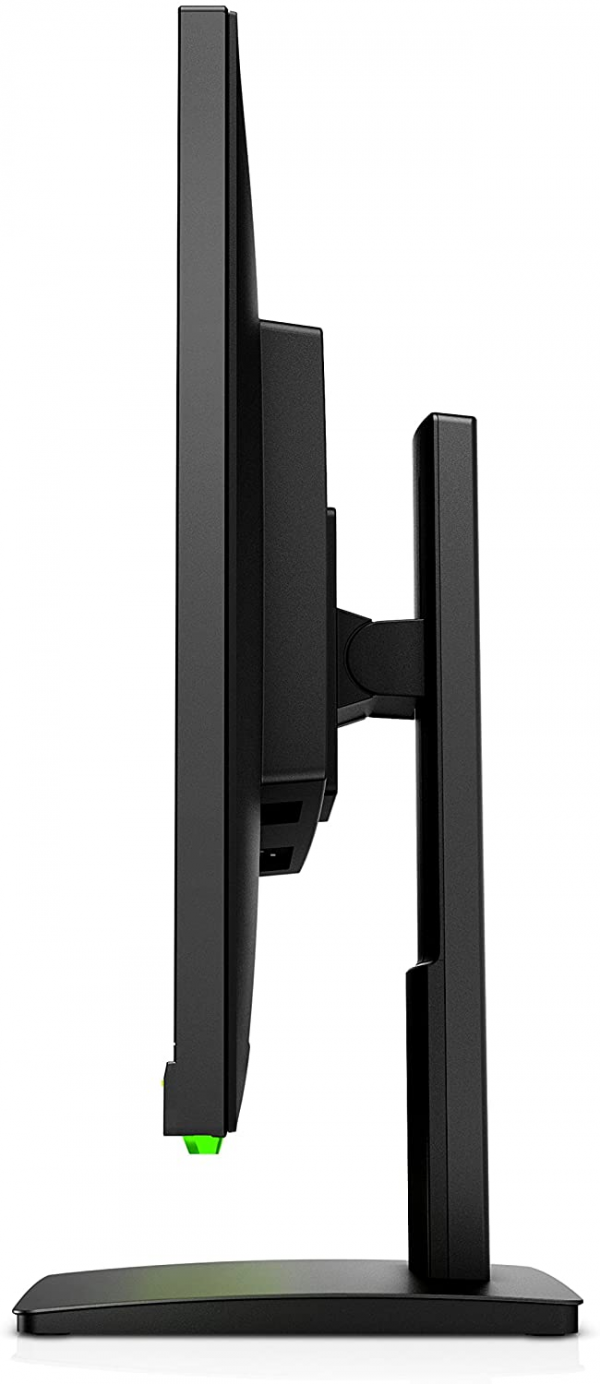
Reactivity
This screen uses pulse width modulation (PWM or "Pulse Width Modulation") to manage the LEDs of the backlight system (it is not Flicker-Free). There is therefore a risk of flickering when the brightness is lowered, which can cause eye fatigue and headaches in the most sensitive people. On the other hand, it has a blue light reduction mode, but the latter operates via software adjustment.
The HP 27xq monitor is compatible with FreeSync technology which dynamically shifts the screen refresh rate to the number of images per second produced by the graphics card, in order to avoid the phenomenon of image tearing (tearing) and micro-slowdowns (stuttering). The frequency range supported is quite wide since the FreeSync works here between 48 and 144 Hz. It is also supported by Nvidia graphics cards which, since the publication of the GeForce 417.71 drivers, can support FreeSync / AdaptiveSync.
The 5 ms reactivity is excellent in absolute terms, but average for a TN panel. Indeed, some VA monitors such as the MSI Optix MAG271CR (5 ms), the Samsung C32HG70 or the Iiyama G-Master G3266HS also achieve a remanence time of 5 ms, while displaying better contrast and better viewing angles. The best TN monitors come down to 3 ms, like the Alienware AW2518HF or 3.5 ms for the Acer Predator XB252Q, XB272, and BenQ Zowie XL2540. This value of 5 ms is obtained with a setting of the overdrive to "level 4", without showing any reverse ghosting effect.
We measured the delay on display (input lag) at 9.7 ms. There is therefore no discernible lag between the sending of the image by the graphics card and its display on the screen.
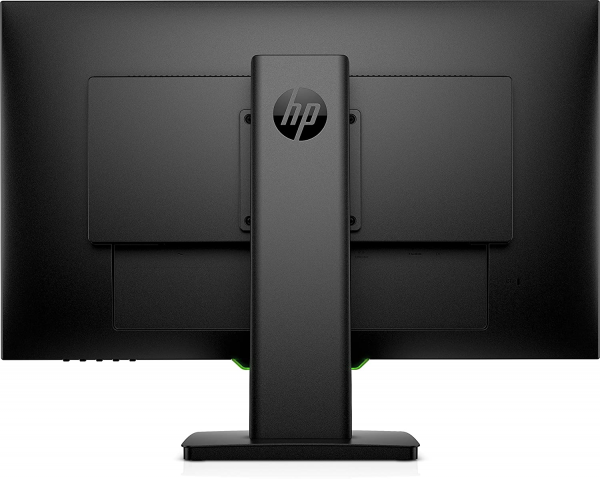
Conclusion
The HP 27xq monitor suffers from comparison with its main competitors, the closest of which is undoubtedly the AOC AG271QX. The latter does better on all points (image quality, contrast, consumption, ergonomics). Only the price of the HP model can play in its favor.
Specifications

